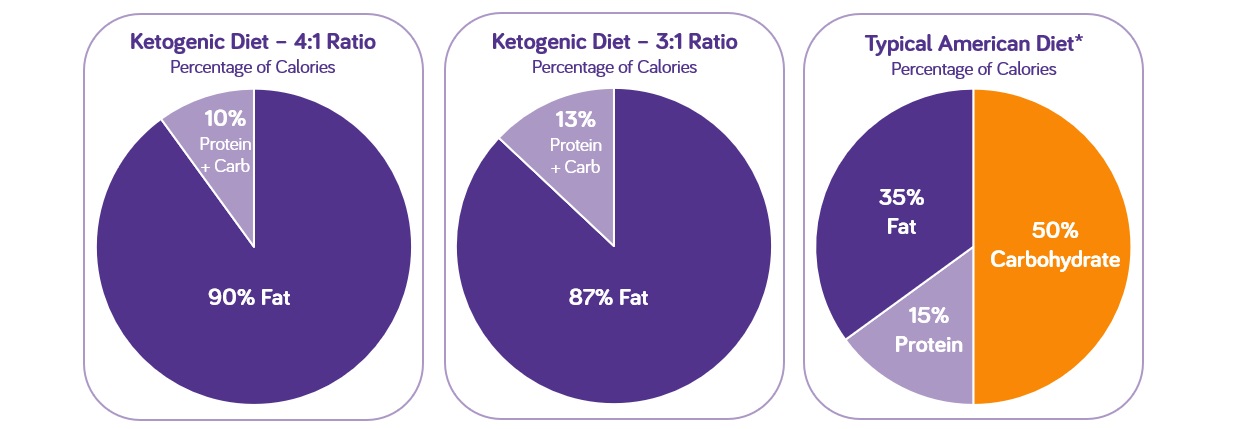If your child’s physician has recommended a ketogenic diet for epilepsy management, you likely have many questions, which may have led you to this post. As you collect information online and educate yourself on the topic, you may come across the term “ketogenic ratio” and wonder what it means.
A “ketogenic ratio”, represents the amount of fat in the diet, in comparison to the amount of protein plus carbohydrate. The infographic provided below as well as this quick video created by Zahava Turner, keto registered dietitian, can also help explain what ketogenic diet ratios are.

Ketogenic Ratios Based on Grams
Classic ketogenic diets mostly use ketogenic ratio ranges between 4:1 and 3:1. A 4:1 ketogenic ratio describes a ketogenic diet that is made of 4 grams of fat for every 1 gram of protein plus carbohydrate. In other words, for every 5 grams of food consumed, there are 4 grams of fat and 1 gram of protein plus carbohydrate. Therefore,
- a 4:1 ketogenic diet contains
- 80% fat (4 g ÷ 5 g = 80%) and
- 20% protein plus carbohydrate (1 g ÷ 5 g = 20%)
- a 3:1 ketogenic diet contains
- 75% fat (3 g ÷ 4 g = 75%) and
- 25% protein plus carbohydrate (1 g ÷ 4 g = 25%)
Notice that the ketogenic ratio compares the amount of fat, protein, and carbohydrates in grams, a measure of weight. This is because the classic diet is calculated in grams, since foods are measured by weight using a gram scale.
Ketogenic Ratios Based on Calories
If you compared fat, protein, and carbohydrates based on calories provided from each (rather than the number of grams of each), the ratio would be a little different because fat provides more calories per gram than protein and carbohydrates do. Each gram of fat provides the body with 9 calories, while each gram of protein or carbohydrate provides the body with 4 calories.
For example, let’s say that you need to consume 360 calories. To provide 360 calories from protein and/or carbohydrate (which both provide 4 calories per gram), you would need to eat 90 grams of protein and/or carbohydrate (360 kcal ÷ 4 kcal/g = 90 g).
However, to get the same number of calories from fat, you would need to eat just 40 grams of fat (360 kcal ÷ 9 kcal/g = 40 g). Fat provides calories with much less mass as it is more calorically dense than protein and carbohydrates. For this reason, ketogenic meals tend to look smaller than standard meals, even when they provide the exact same number of calories.
If a child is on a 4:1 ketogenic ratio, 90% of the calories in their diet comes from fat. Did we lose you there?
This can be confusing because “how can it be both 80% fat and 90% fat?”. The answer is that it is 80% fat if you are measuring by weight and 90% fat if you are measuring by calories.
Remember that a 4:1 ketogenic ratio represents: 4 grams of fat:(for every)1 gram of carbohydrate plus protein
- 4 grams of fat (which provides 9 calories per gram) provides a total of 36 calories (4 x 9 kcal = 36 kcal).
- 1 gram of protein or carbohydrate (which provides 4 calories per gram) provides a total of 4 calories (1 x 4 kcal = 4 kcal).
The ratio of calories from fat to calories from protein plus carbohydrate is 36:4. This means that for every 40 calories consumed, 36 come from fat and 4 come from protein and/or carbohydrate. Thus, 90% of the calories comes from fat (36 kcal ÷ 40 kcal = 90%), and 10% comes from protein and carbohydrate (4 kcal ÷ 40 kcal = 10%).
On a 3:1 ketogenic diet, about 87% of the calories comes from fat, and 13% comes from protein plus carbohydrate. For comparison’s sake, a typical American diet contains about 35% of calories from fat and about 65% from protein and carbohydrate.

Click here for more information on medical ketogenic diet variations for epilepsy.
*Adapted from: Freedman MR, King J, Kennedy E. Popular diets: a scientific review. Obes Res 2001; 9(suppl 1):3S,11S,12S.
Brought to you by Nutricia North America
Always consult with your ketogenic clinician prior to making any changes to your ketogenic diet or condition management.
©Nutricia North America 2025

